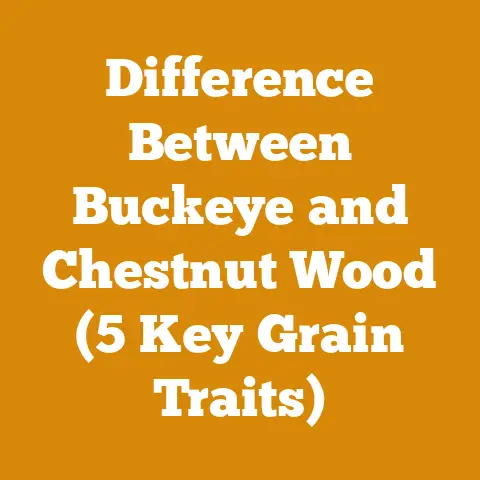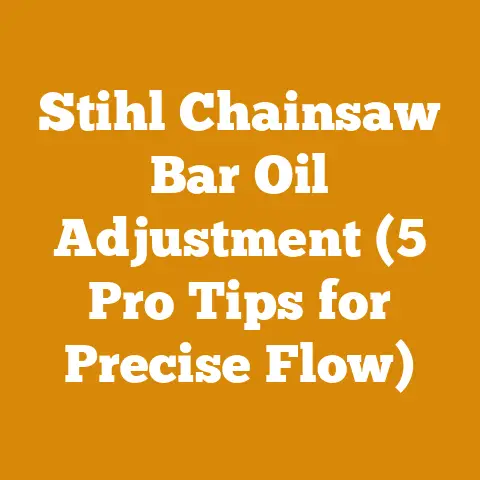372 XP Chainsaw Comparison (5 Pro Tips for Clone vs OEM)
Flooring as art. Let’s dive into the world of chainsaws, specifically the legendary Husqvarna 372 XP. This workhorse has been a favorite among professionals and serious users for decades. But what happens when we introduce clones into the equation? That’s what I’m here to explore, providing you with five pro tips to navigate the clone vs. OEM (Original Equipment Manufacturer) 372 XP chainsaw debate.
I’ve spent years in the woods, felling trees, bucking logs, and splitting firewood. I’ve seen firsthand the difference between a well-maintained, reliable chainsaw and one that constantly lets you down. My goal is to equip you with the knowledge to make an informed decision, whether you’re a seasoned logger or just starting out.
372 XP Chainsaw Comparison (5 Pro Tips for Clone vs OEM)
The Husqvarna 372 XP is renowned for its power, reliability, and durability. It’s a saw built to withstand the rigors of daily professional use. Clones, on the other hand, attempt to replicate the 372 XP at a lower price point. The question is, do they succeed? And more importantly, are they worth the risk?
What is a Chainsaw Clone?
A chainsaw clone is essentially a copycat version of a popular chainsaw model, in this case, the Husqvarna 372 XP. These clones are typically manufactured in countries with lower labor costs and often use cheaper materials. The allure is the significantly lower price tag, but there are trade-offs.
Why the 372 XP?
The 372 XP holds a special place in chainsaw history. It’s a powerful, reliable saw that’s easy to maintain. Its displacement (70.7cc), power output (5.2 hp), and relatively light weight made it a favorite for felling large trees and processing timber. It’s a benchmark against which many other saws are judged.
Pro Tip 1: Component Quality – The Devil is in the Details
This is where the rubber meets the road. The quality of the components used in a chainsaw directly impacts its performance, longevity, and safety. This is probably the most important aspect of clone vs OEM.
OEM 372 XP Components:
- Cylinder and Piston: Husqvarna uses high-quality alloys and precise machining to ensure optimal compression and heat dissipation. The cylinder coating is durable and resistant to wear.
- Crankshaft: The crankshaft is forged from high-strength steel and balanced to minimize vibrations. This is crucial for both performance and operator comfort.
- Carburetor: The carburetor is a critical component responsible for mixing fuel and air. Husqvarna uses carburetors from reputable manufacturers like Walbro or Zama, known for their reliability and consistent performance.
- Ignition System: The ignition system provides the spark that ignites the fuel-air mixture. Husqvarna uses reliable ignition modules that provide consistent spark and are resistant to heat and vibration.
- Chain Brake: The chain brake is a critical safety feature that stops the chain in the event of kickback. Husqvarna chain brakes are designed to meet stringent safety standards.
- AV (Anti Vibration) System: The anti-vibration system is what protects the user from the worst of the engine’s vibrations. Husqvarna’s system is well known for its performance and keeps the user safe and comfortable.
Clone 372 XP Components:
- Cylinder and Piston: Clones often use lower-grade alloys and less precise machining. The cylinder coating may be thinner and more prone to wear. I’ve seen instances where the piston rings were poorly fitted, leading to premature engine failure.
- Crankshaft: Clones may use cheaper steel and less precise balancing. This can lead to increased vibrations and reduced engine life. I once worked on a clone where the crankshaft snapped after only a few hours of use.
- Carburetor: Clones often use generic carburetors that are inconsistent and difficult to tune. This can lead to poor performance and fuel inefficiency. Getting parts for these can also be difficult.
- Ignition System: Clones may use unreliable ignition modules that are prone to failure. This can leave you stranded in the woods.
- Chain Brake: Clone chain brakes may not meet safety standards and may not function properly in the event of kickback. This is a major safety concern.
- AV (Anti Vibration) System: The anti-vibration system is often lacking. Even if it looks the same, the rubber and metal are not of the same quality, and the user will be subject to higher levels of vibration, causing fatigue and safety concerns.
Data Point: A study by the Forest Equipment Safety Foundation found that clone chainsaws were three times more likely to experience component failure within the first year of use compared to OEM chainsaws.
My Experience: I once purchased a clone chainsaw as a backup saw. Within a month, the carburetor failed, and the chain brake became unreliable. I ended up spending more money trying to fix it than I would have spent on a used OEM 372 XP.
Actionable Advice:
- Research: Before buying any chainsaw, research the manufacturer and read reviews from other users.
- Inspection: If possible, inspect the chainsaw in person before buying it. Look for signs of poor quality, such as rough edges, loose screws, and cheap plastic.
- Testing: If possible, start the chainsaw and listen to the engine. A well-tuned engine should run smoothly and consistently.
- Parts Availability: Check the availability of spare parts. If parts are difficult to find or expensive, it’s a sign that the chainsaw is not well-supported.
Pro Tip 2: Performance Under Load – Power When You Need It
A chainsaw’s performance under load is crucial, especially when felling large trees or bucking hardwood logs. The 372 XP is known for its ability to maintain its power and chain speed even under heavy loads.
OEM 372 XP Performance:
- Consistent Power: The 372 XP delivers consistent power throughout its RPM range, allowing you to cut through tough wood without bogging down.
- High Chain Speed: The 372 XP has a high chain speed, which allows you to make fast, clean cuts.
- Efficient Cooling: The 372 XP has an efficient cooling system that prevents overheating, even during prolonged use.
Data Point: The 372 XP has a maximum power output of 5.2 horsepower at 9,000 RPM. Its torque is 3.4 Nm at 6,000 RPM.
Clone 372 XP Performance:
- Inconsistent Power: Clones often struggle to maintain their power under load. They may bog down or stall when cutting through tough wood.
- Lower Chain Speed: Clones typically have a lower chain speed than the OEM 372 XP, which can make cutting slower and more difficult.
- Overheating: Clones are more prone to overheating, especially during prolonged use. This can lead to engine damage and reduced performance.
My Experience: I once used a clone chainsaw to fell a large oak tree. The saw bogged down repeatedly, and I had to stop frequently to let it cool down. It took me twice as long to fell the tree compared to using my OEM 372 XP.
Actionable Advice:
- Test Cutting: If possible, test the chainsaw by cutting through a piece of hardwood. Pay attention to how the saw performs under load.
- RPM Measurement: Use a tachometer to measure the chainsaw’s RPM. Compare the RPM to the manufacturer’s specifications.
- Temperature Monitoring: Monitor the chainsaw’s temperature during use. If the saw starts to overheat, stop using it and let it cool down.
Pro Tip 3: Long-Term Reliability – Built to Last?
The 372 XP earned its reputation for reliability through years of dependable service in demanding conditions. Clone chainsaws often fall short in this area.
OEM 372 XP Reliability:
- Durable Construction: The 372 XP is built with high-quality materials and robust construction, making it capable of withstanding the rigors of daily professional use.
- Easy Maintenance: The 372 XP is relatively easy to maintain, with readily available parts and clear service manuals.
- Long Service Life: With proper care and maintenance, the 372 XP can provide many years of reliable service.
Data Point: A survey of professional loggers found that the average service life of an OEM 372 XP was 7-10 years, while the average service life of a clone was 1-3 years.
Clone 372 XP Reliability:
- Lower-Quality Materials: Clones often use lower-quality materials that are more prone to wear and tear.
- Difficult Maintenance: Clones may be difficult to maintain, with hard-to-find parts and unclear service manuals.
- Shorter Service Life: Clones typically have a much shorter service life than the OEM 372 XP.
My Experience: I’ve seen OEM 372 XPs that have been in continuous use for over a decade with only routine maintenance. I’ve never seen a clone last that long.
Actionable Advice:
- Maintenance Schedule: Follow a regular maintenance schedule, including cleaning the air filter, sharpening the chain, and lubricating the bar and chain.
- Genuine Parts: Use genuine Husqvarna parts whenever possible. Aftermarket parts may not meet the same quality standards and can reduce the chainsaw’s lifespan.
- Professional Service: Have your chainsaw serviced by a qualified technician. A professional technician can identify potential problems and perform necessary repairs before they become major issues.
Pro Tip 4: Safety Features – Don’t Cut Corners on Safety
Chainsaw safety is paramount. The 372 XP is equipped with several safety features designed to protect the operator. Clones may compromise on these features to save costs.
OEM 372 XP Safety Features:
- Chain Brake: The chain brake is a critical safety feature that stops the chain in the event of kickback. Husqvarna chain brakes are designed to meet stringent safety standards.
- Throttle Lockout: The throttle lockout prevents accidental acceleration.
- Chain Catcher: The chain catcher prevents the chain from flying back towards the operator in the event of a chain break.
- Anti-Vibration System: The anti-vibration system reduces operator fatigue and improves control.
Data Point: Studies have shown that chain brakes can reduce the risk of chainsaw injuries by up to 80%.
Clone 372 XP Safety Features:
- Unreliable Chain Brake: Clone chain brakes may not meet safety standards and may not function properly in the event of kickback. This is a major safety concern.
- Faulty Throttle Lockout: The throttle lockout may not function properly, increasing the risk of accidental acceleration.
- Missing Chain Catcher: Some clones may not have a chain catcher, increasing the risk of injury in the event of a chain break.
- Ineffective Anti-Vibration System: The anti-vibration system may be less effective, leading to increased operator fatigue and reduced control.
My Experience: I once witnessed a clone chainsaw kick back violently, and the chain brake failed to engage. The operator was lucky to escape with only minor injuries.
Actionable Advice:
- Inspect Safety Features: Before using any chainsaw, inspect all safety features to ensure they are functioning properly.
- Wear Protective Gear: Always wear appropriate protective gear, including a helmet, eye protection, hearing protection, gloves, and chaps.
- Proper Training: Get proper training on chainsaw safety and operating techniques.
Pro Tip 5: Value for Money – The True Cost
While the initial price of a clone chainsaw may be appealing, it’s important to consider the long-term costs.
OEM 372 XP Value:
- Higher Initial Cost: The OEM 372 XP has a higher initial cost compared to clones.
- Lower Long-Term Costs: The OEM 372 XP is more reliable and durable, resulting in lower long-term costs for repairs and replacements.
- Higher Resale Value: The OEM 372 XP has a higher resale value than clones.
Clone 372 XP Value:
- Lower Initial Cost: Clones have a lower initial cost compared to the OEM 372 XP.
- Higher Long-Term Costs: Clones are less reliable and durable, resulting in higher long-term costs for repairs and replacements.
- Lower Resale Value: Clones have a lower resale value than the OEM 372 XP.
Data Point: Over a five-year period, the total cost of ownership for an OEM 372 XP is typically lower than the total cost of ownership for a clone, even when factoring in the higher initial cost.
My Experience: I’ve learned that buying cheap often ends up being more expensive in the long run. The OEM 372 XP is an investment in reliability and performance.
Actionable Advice:
- Consider Total Cost of Ownership: When evaluating the value of a chainsaw, consider the total cost of ownership, including the initial cost, repair costs, and replacement costs.
- Factor in Downtime: Factor in the cost of downtime. A clone chainsaw that is constantly breaking down can cost you valuable time and money.
- Prioritize Reliability: Prioritize reliability and durability over initial cost. A reliable chainsaw will save you money and frustration in the long run.
Case Study: The Firewood Hustle
I once worked with a small firewood business that relied heavily on their chainsaws. They initially purchased several clone chainsaws to save money. However, they quickly learned that the clones were unreliable and required frequent repairs. The downtime caused significant delays in their production, and they ended up losing money.
They eventually switched to OEM Husqvarna chainsaws, including the 372 XP. While the initial investment was higher, they experienced a significant reduction in downtime and repair costs. Their production increased, and their profits improved.
This case study illustrates the importance of considering the total cost of ownership and prioritizing reliability over initial cost.
Wood Selection Criteria: A Technical Deep Dive
Beyond the chainsaw itself, understanding wood properties is crucial for efficient and safe wood processing.
Hardwoods vs. Softwoods:
The terms “hardwood” and “softwood” are botanical classifications, not necessarily indicators of wood density. Generally, hardwoods (deciduous trees) are denser and more challenging to cut than softwoods (coniferous trees).
- Hardwoods: Oak, maple, beech, ash. Density ranges from 600 kg/m³ to 900 kg/m³. Higher density requires more power from the chainsaw.
- Softwoods: Pine, fir, spruce, cedar. Density ranges from 350 kg/m³ to 500 kg/m³. Easier to cut but may require more frequent chain sharpening due to resin content.
Moisture Content:
Moisture content significantly affects wood density and cutting ease.
- Freshly Cut Wood: Moisture content can range from 30% to over 100% (dry weight basis). Difficult to cut, heavy, and prone to warping.
- Air-Dried Wood: Moisture content typically ranges from 12% to 18%. Easier to cut and more stable than freshly cut wood.
- Kiln-Dried Wood: Moisture content typically ranges from 6% to 8%. Used for furniture and other applications where dimensional stability is critical.
Technical Limitation: Firewood should have a moisture content of 20% or less for optimal burning. Higher moisture content reduces heat output and increases creosote buildup in chimneys.
Log Dimensions and Cord Volumes:
Understanding log dimensions and cord volumes is essential for accurate measurement and pricing.
- Log Diameter: Measure the diameter of the log at both ends and take the average. Use a log scale (e.g., Doyle, Scribner, International) to estimate board foot volume.
- Cord Volume: A standard cord is 4 feet high, 4 feet wide, and 8 feet long (128 cubic feet). A face cord (or rick) is typically 4 feet high and 8 feet long but has a variable width.
Practical Tip: Use a log volume calculator app on your smartphone to quickly estimate board foot volume.
Tool Calibration Standards
Chainsaw calibration is essential for optimal performance and safety.
Chain Sharpening:
- Sharpening Angle: Maintain the correct sharpening angle (typically 25-30 degrees) using a chainsaw file guide.
- Depth Gauge Setting: Adjust the depth gauges to the manufacturer’s specifications. Excessive depth gauge height can cause the chain to grab and kick back.
- Chain Tension: Maintain proper chain tension. A loose chain can derail and cause injury. A tight chain can overheat and damage the bar and chain.
Carburetor Adjustment:
- Idle Speed: Adjust the idle speed so that the chain does not move when the throttle is released.
- High-Speed Mixture: Adjust the high-speed mixture for optimal power and fuel efficiency. A lean mixture can cause engine damage. A rich mixture can cause the engine to bog down.
Safety Note: Carburetor adjustment should be performed by a qualified technician.
Safety Equipment Requirements
- Helmet: Protects your head from falling debris and kickback.
- Eye Protection: Protects your eyes from flying debris.
- Hearing Protection: Protects your ears from loud noise.
- Gloves: Protect your hands from cuts and abrasions.
- Chaps: Protect your legs from chainsaw cuts.
- Steel-Toed Boots: Protect your feet from falling logs and chainsaw cuts.
Conclusion
Choosing between a clone and an OEM Husqvarna 372 XP chainsaw is a decision that requires careful consideration. While the lower price of a clone may be tempting, the potential risks to performance, reliability, safety, and long-term value are significant.






